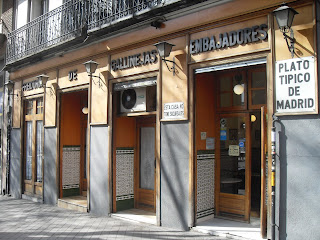
Perhaps one of the more striking differences between Spanish cuisine and delicate Anglo-Saxon tastes is to be found in the local carnicería, where chicken feet hang snugly alongside pig’s trotters and liver and kidneys glisten proudly below.
A glance at a standard tapas menu shows an equal commitment to using every last inch of an animal’s flesh, from pig’s ear to ox tail to blood sausage to sherry-doused kidneys. Spain’s is a food culture that embraces the bits that we from more northerly climes tend to shun.
For all this country’s pretensions at fancy pinchos and Michelin stars, this is where the real heart of Spanish cooking lies: in the innards, intestines and, indeed, hearts of their farmyard beasts. Nowhere is this more true than in Madrid itself, where you’ll find its trademark dish of callos—slippery tripe hidden in an unassuming tomato sauce—or the near-forgotten gallinejas y entresijos, which once formed the base of the capital’s dinner.
So, in search of a hit of Madrileño tradition and culture, I headed to Freiduría de Gallinejas, Embajadores 84 to munch on innards and take a step back to a time when each part of the animal was valued, and squeamishness just didn’t get a look in.
Gallinejas are strips of the small intestine of a young lamb, while entresijos are a chunk of the same part, but come complete with the spleen and sweetbreads from the pancreas. Both are fried in the fat of the same animal. Using a derivative of the Spanish word for hen, gallina, they take their names from a less abundant era when people were accustomed to eating every last morsel of their animals, down to the stomachs of their little chickens. The name did a species jump to lamb in the 1950s, but can still be found in many Spanish dictionaries erroneously referring to only “tripas fritas de gallina” (fried chicken stomachs).
The restaurant is laid out around a tiny kitchen with open windows. The gentle sizzle of hot fat hums through the air. Freshly fried for every order, the little white strips are flung into gigantic black vats of suet, curving round into little spirals from the heat. Salt is sprinkled over as they are plated up, alongside thin potatoes fried in the same fat. We ordered a plate of gallinejas, and another of entresijos, plus some cold beers, a salad, and more lamb—this time mollejas (neck sweetbreads) for a variation on an offal theme. Our novice faces betrayed the need of an explanation from the friendly waiter who talked us through the various intestine sections more than once due to my inability to spot the difference between them.
As well as a lamb-lover’s haven, this blue-tiled restaurant is also a place for history fans. Gabino Domingo Andrés, the owner of the Freiduría, couldn’t quite remember when he moved to Madrid from his village to help his aunt with the business; “1953 or 1954 perhaps,” he told us. He was around 12 years old, sent upon the orders of his mother to earn the bread for himself and his five younger siblings. Propped up behind the bar taking orders, little Gabino shrunk in embarrassment at having to deal with strangers, especially if those strangers were girls.
In those days, the overspill and leftovers from the nearby Legazpi slaughterhouse were divided among the numerous kiosks and bars that dotted the neighbourhood. Today, this humble local has outlived the other 60, with its group of diehard regulars and a growing stream of intrigued passers-by wanting to know what the frilly white spirals are.
Gabino has obviously left behind the shame that used to burn his cheeks red, proving himself to be quite the storyteller these days. He has published a small collection of books about his childhood, copies of which line the entranceway, and there is another on its way.
When I ask him if he has noticed people’s tastes turning away from offal over the last few decades, he acknowledges that his restaurant’s fare is not for the weak of stomach. He adds proudly, however, that people must like it, because otherwise he wouldn’t still be in business with his team of 11 staff.
So, what are these spirals of fried insides actually like? Are they, bathed in lamb grease, as beastly as they sound?
Their crispy outer frill gives a satisfying crunch, backed up by the deep dark taste of lamb. The slender tubes are anything but rubbery, despite their faint elastic stretch. The gallinejas and entresijos, being part of the same thing, not only look very similar, but taste almost exactly the same. It is unmistakably offal, but rather than overpowering and heavy, its crispy punch is like perfect hangover food, especially if accompanied by some of those javelin potatoes. The sweetbreads were also delicious; their soft richness wrapped up in deep-fried crunch, all washed down with a glass of Mahou and a simple salad. A good bite back into a tasty past.
Embajadores 84, Freiduría de Gallinejas, C/ Embajadores 84 (Metro: Embajadores). Tel: 91 517 59 33. http://www.mformacion.com/gallinejas. Open daily 11am-11pm.
This article was also published in the May issue of InMadrid

This sounds like a little gem of a place! Especially love your description of the owner and the freiduría's history. The only times I've eaten tripe and sweetbreads has been in Spain, they're just not on the menu in the UK. We're even squeamish about eating liver and kidney in our pies... Anyway, I hope this place stays open for another half a century so I can visit it!
ResponderEliminar